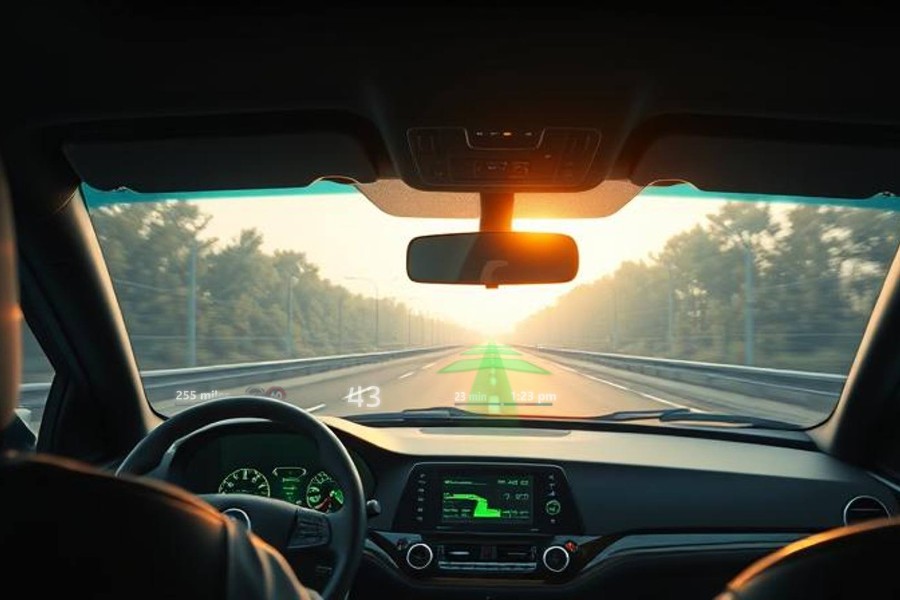Posted: Wednesday, July 2, 2025
AR Windshield: A Heads-Up Display for Tomorrow
A Technological Marvel with Great Potential...and Considerable Distraction

AR Windshield: Through the display of what the car "perceives" and "decides", the AR HUD promotes trust in automation.
Officially known as the Light-Chasing Panoramic Display, Huawei's collaboration with XPeng on the cutting-edge AR Windshield is more than just a technological advancement for cars; it's a whole sci-fi-themed experience for daily travel. This isn't your typical head-up display (HUD). With its 87-inch, windshield-spanning, 2K-resolution screen, it turns the road into an interactive digital world that combines augmented components that seem to be lifted straight out of a state-of-the-art racing simulation with real-world driving.
Beyond Brightness: Where Theatrical Immersion and Navigation Collide
The sheer size of the display is initially quite impressive. Its 12,000 nit brightness and 1,800:1 contrast ratio are designed to ensure visibility in various situations, such as during foggy night drives or under bright sunlight. However, immersion is as crucial as visibility. Alongside indicating directions, navigation arrows float over the road. Lane guidance illustrates your path ahead; it doesn't simply indicate turns. You might say Google Maps has a flair for dramatic design.
In essence, the system provides a remarkable illustration of integration. While XPeng provides the software intelligence, tailoring the information displayed based on the driving conditions at the moment, Huawei provides the hardware strength—high-resolution optics, AI-enhanced rendering. The result is a windshield that anticipates needs in addition to providing information. The display functions more like a co-pilot than just a screen, whether it's warning of an impending abrupt curve or alerting a pedestrian who is about to cross the path.
The "follow-light carpet", a dynamic visual effect that adapts to road conditions and navigation cues, is one of the most talked-about features. It is undoubtedly enjoyable, but it also serves a purpose by improving spatial awareness and reducing the cognitive load on the driver. This is a rare instance where functionality and beauty coexist harmoniously, producing an absolutely amazing end product.
Through the Windshield, Carefully: Balancing Spectacle and Safety in AR Driving Display
But we must face the obvious problem: distraction. According to critics, turning your entire field of vision into a digital interface may cause sensory overload, especially in complex driving scenarios. They're not entirely wrong. The flurry of animations, alerts, and overlays seen in clips from the launch event may potentially be confusing to a motorist who is not used to this level of visual stimulation.
In light of this, it seems that XPeng and Huawei are aware of the possible risks. In order to reduce distractions when cruising and to provide more details during navigation or autonomous driving, the system is designed to prioritize information based on context. Despite its flaws, it shows a thoughtful attempt to strike a compromise between safety and functionality. In an era where drivers are already juggling instrument panels, cellphones, and infotainment screens, combining all of that data into a single, intuitive interface may eventually reduce distractions.
Upcoming Windshield: Transitioning from Glass to Guidance in the Era of Independence
The AR Windshield is a daring statement in terms of design. Beyond just being practical, it represents a shift in how we interact with cars. The days of battling with center consoles or staring down at dashboards are long gone. The car increasingly serves as a transparent interface where the road and the information that is helping you live side by side.
Additionally, the technology points to a more ambitious objective: preparing drivers for a time when driving will be done by autonomous systems. Through the display of what the car "perceives" and "decides", the AR HUD promotes trust in automation. It shows you the rationale behind the claim that changing lanes is safe, not just that it is. The transition to self-driving automobiles may be greatly aided by this clarity.
High-Tech Comes at a High Ticket: Huawei's AR Windshield as a Wake-Up Call
Of course, there is a price for this level of inventiveness. The XPeng G7, a $35,000 electric SUV made for the Chinese market, is the first vehicle to use the system. Although its introduction to international markets is questionable, its very existence serves as a reminder to conventional manufacturers that the cockpit has evolved from a plain place to sit to a digital space that is ready for innovation.
Ultimately, Huawei’s AR Windshield is more than just a device—it represents a peek into the changing connection between people and technology. It’s daring, it’s visionary, and it could be considered somewhat extravagant. Yet in an era where vehicles are transforming into mobile computers, perhaps a bit of flair is precisely what we require to remain focused on the road. Or more accurately, through it.